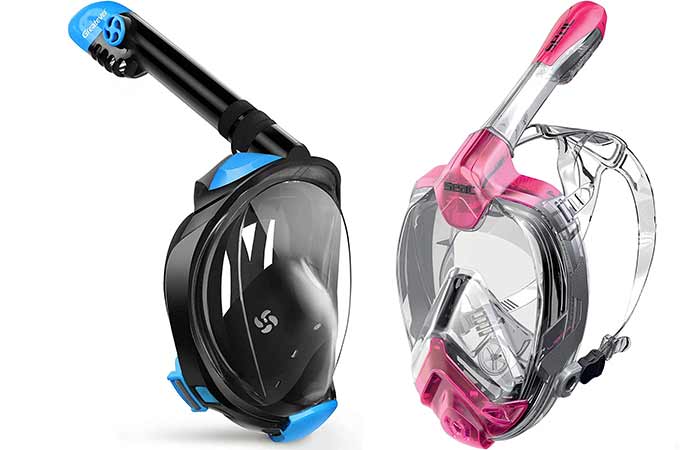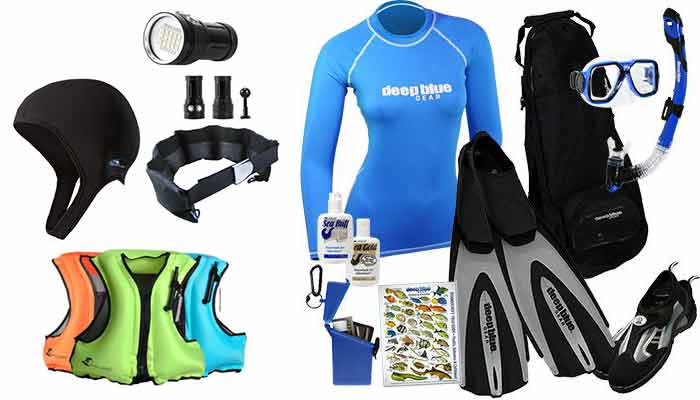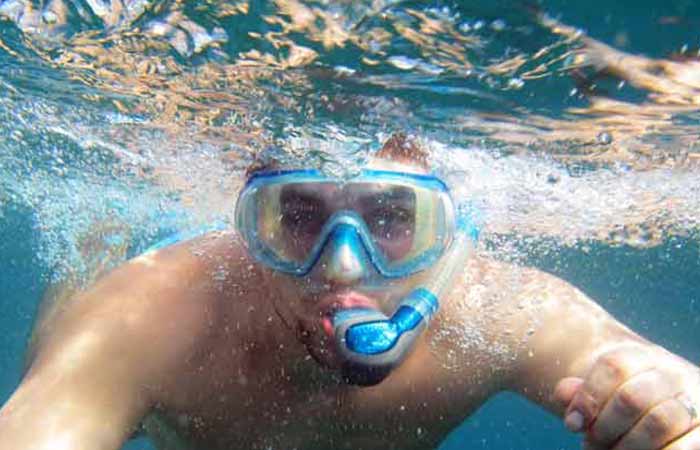How to Snorkel: Beginner Guide+Snorkeling Tips
Learning how to snorkel is one of the easiest, quickest, and most affordable ways to see and enjoy the colorful and fascinating world beneath the sea in all its glory. Having this skill can make your next beach vacation incredibly exceptional.
First, you need the right gear. The next step is learning to set up the gear properly. Practicing in water is important, especially if you’re a beginner who has not swum before. Once you’ve got the fundamentals, find a good snorkeling spot and enjoy the underwater world.
Following is a complete guide from the basic snorkeling skills you need, safety practices and tips for both beginners and advanced snorkelers.
Select the Right Gear
Having the right gear is a prerequisite for a comfortable and seamless snorkeling experience. A face mask, a snorkel and a pair of fins comprise the basic gear set for snorkeling. If you’re an absolute beginner with zero swimming skills, you may need a flotation device.
Snorkel Mask
A mask is a piece of underwater equipment you wear over your face to allow you to see clearly underwater while snorkeling. It creates a watertight seal around its edges to keep water out of your eyes.
Depending on the level of your experience, you can choose either a full-face mask or regular/traditional dive-style mask.
Full-face masks, combine a mask and a snorkel and cover your entire face, including your eyes, nose and mouth. This type is ideal for beginners because it is easy to use.
Further Reading: Best Full-face Snorkel Masks + Buy Guide
Traditional dive-style masks cover a portion of your face, especially your eyes and nose. It does not have an inbuilt snorkel tube. While this type of mask is quite uncomfortable to use, especially for beginners, it is lightweight and allows you to dive deeper under the water. It is ideal for individual who have some basic diving skills.
Consider a prescription snorkel mask if you have poor eyesight. Mask with prescription adjustment can, help you see underwater without your glasses or using contact lenses.
Snorkel
A snorkel is a tube-like apparatus that allows you to breathe through your mouth while you are floating on the water surface, your face immersed in the water.
This accessory goes hand in hand with a regular snorkel mask. You do not need a snorkel if you are using a full-face mask.
Like masks, snorkels come in various styles/types and what you go for depends on the level of your water skills. The most ideal type for beginners is the dry or dry-top snorkel.
A dry snorkel has a built-in mechanism that keeps out water if you intentionally or unintentionally submerge the entire snorkel. This eliminates the burden of having to clear salty sea water from the snorkel tube every now and again. In diving, clearing is a technique of its own that you have to learn and practice.
If you have some basic diving skills, the best option is semi-dry and if you’re an experienced diver, you can get the classic snorkel (wet snorkel) which is just a basic tube with a mouthpiece.
Further Reading: How a Snorkel Works, Types and Review of the Best.
Fins/Flippers
Fins are water accessories you wear on your feet to help you move through the water more efficiently. While flippers come in different styles and sizes for various purposes and skill levels, a short, lightweight, and flexible pair of flippers is what you need as a beginner.
Short fins with soft full-foot pockets are the best choice for beginner snorkelers. The short blades are relatively stiffer, which helps in changing directions and moving forward while snorkeling. In addition, they are easy to pack.
Full-foot flippers are easier to use because you transfer more energy from each kick into the water compared to when kicking with open-heeled strapped fins.
Medium-length fins are ideal for intermediaries, while long-blade versions are for experienced divers.
Further Reading: Snorkeling Fins Guide
Floatation Device
A means to keep yourself afloat, most preferably a float vest, can be of great help, especially essential if you are an absolute beginner with no swimming skills. A good float mechanism helps to add an element of buoyancy, which makes swimming easier and conserves energy.
Because snorkeling is an activity that engages almost all of your muscles, it is possible that you’ll get exhausted even if you are an experienced swimmer or diver. Adding a flotation gear will allow you to snorkel for a longer duration without getting tired.
UV Protection
It is also a good idea to have a swimsuit, rash guard or sunscreen to protect your skin from the sun and any abrasive surfaces.
Further Reading: An Exhaustive Collection of Snorkeling Equipment (Gear & Sets)
Once you have the right snorkel gear in place, the next step is to familiarize yourself with the gear before you try them out in the water. This will help you understand how to use each piece of equipment properly, hence making you comfortable and confident the moment you get into the water.
Most snorkeling gear is easy to use, all you need is to put them on and adjust for a comfortable fit. Remember to check through any instructions that come with each gear.
Practicing: Basic Swimming & Snorkeling Skills
Once you’ve got yourself the right gear and familiarized yourself with how each looks like and works, it is time to get into water for practice. You can use a swimming pool or a calm shallow end of the beach.
Fundamental Water Skills
While knowing how to swim is not an absolute necessity for snorkeling, if you can, we strongly recommend that you take at least a few classes at your local pool beforehand.
These classes will most likely touch on breathing, commonly known as bubbling, floating on your belly, back and maybe vertically (water treading), kicking with your legs to move from one point to another, basic arm movements and standing (transitioning from a horizontal to a vertical position when in water.
These are not only fundamental water survival techniques that can help during a disaster, especially when you have no float aid, but also important skills that use in all water sports and activities.
Prior swimming skills and practice will give you greater control of yourself while snorkeling, as well as improve your endurance and strength, making the entire experience enjoyable and less tiring.
Having swimming skills can also save you space and money; you won’t have to buy and carry more snorkel gear. Extra gear such as vests and full-face masks are not only costly and bulky but can also restrict your mobility and prevent you from diving underwater to explore more.
Beginner Snorkeling Skills
After taking some basic swim lessons, you are now ready to learn and practice fundamental snorkeling skills. If you were not lucky enough to take the basic swimming lessons, do not worry, a flotation aid can be of great help.
The point of this is to get an idea of how lying on the surface of the water, breathing through the snorkel, kicking with the fins, and viewing underwater with the mask feels like.
While being an excellent swimmer is a plus, kicking with fins while breathing through a snorkel can be quite challenging, especially if you have not tried it before. Hence, you definitely want to practice before your first snorkeling expedition.
Before wearing your gear, the first step is to carry out a quick inspection just to ensure that each of them is in the right working condition. Remove any form of debris, look for any cracks and any other faults, and check through the manuals to set them up correctly. At all costs, do not use gear that is faulty.
Snorkel Gear Setup and Prepping
For a full-face snorkel mask, first fix the snorkel tube into place, then put it on, and adjust the straps to get a secure, comfortable fit. Confirm that the sealer creates an airtight seal all around your face and between your mouth and the eye region. Remove any hair or object that can break the seal and make sure you can see clearly through the lenses.
For a regular mask, put it on, then tug the straps until it feels comfortably sealed around your eyes and nose. Attach the snorkel tube with the mouthpiece facing down and the top of the snorkel above your head. Adjust the position of the snorkel, bite on the mouthpiece and ensure it is comfortable and you can easily breathe.
To put on the fins, simply hold the back of the heel and slip your feet into the foot pocket; toes first. You do this while sitting on the side of the pool or standing at the shallow end and simply slip your feet into the pockets.
Flippers are designed to be worn only in the water. Putting them outside the water can easily damage them and trying to walk in them facing forward is difficult. If, for whatever reason, you have to wear them outside the water, be careful and moonwalk backward into the water.
If you have a flotation vest, add the pressure, put it on and adjust the straps and buckles to ensure it is comfortable and fits correctly.
Once you have set up gear properly, and you are inside the water, it is time to learn and practice some snorkeling basics. It’s best to enter the water from a gently sloping area rather than from a high platform.
Breathing Through the Snorkel
In the shallow area of the pool or beach, bend or squat and place your face in the water; the mask should be submerged. Bite on the mouthpiece and try to breathe in and out through your mouth while view underneath the water.
Although breathing through the snorkel barrel, for the first time, may feel unnatural and it creates an unpleasing loud sound that is noticeable, you’ll eventually get comfortable after a couple of breaths. The trick is to relax while slowly inhaling and exhaling.
Another important thing to practice is removing the snorkel mouthpiece from your mouth and placing it back into your mouth while your face is still underwater.
Floating on your stomach
Once you’re comfortable breathing through the snorkel, the next skill is to learn to float completely flat on your belly. This is the perfect position when snorkeling for both beginners and those with some swimming experience. Floating flat allows you to control your buoyancy, which in turn makes it easy to kick with fins.
If you’ve taken some swimming classes, you already know to float. For those who have not taken basic swimming lessons, follow the steps below.
- Stand in the shallow end of the pool/beach (water level around your waist)
- Bend at the waist and lean forward until the mask is in the water and your snorkel above the surface.
- With your arms extended out in front or beside your thighs, slowly lift one foot, then the other, off the floor and stretch your legs out behind you so that you are lying face down in the water.
- Once you’re flat, relax, then take your time to find some balance while keeping your face looking down and slightly forward.
- Take slow, regular breaths in and out. Breathe slowly, deeply and cautiously with your mouth through your snorkel. Remember to stay calm and aware of how you are breathing.
- If something doesn’t feel right, you can always stand up and address the problem.
- If you’re finding it hard to float, wear a buoyancy vest as it makes floating on the surface of the water much easier
Kicking with Fins for Propulsion
Kicking is the primary mode of propulsion when snorkeling. While there are several ways to use your legs to move around water while snorkeling, most snorkelers and beginners usually use flutter kicks as the default finning technique, because it is the easiest to learn, and it is the most common way to kick swimming (freestyle stroke). It is also useful when swimming against the current.
To kick properly while snorkeling, follow the steps below
- Float flat, with your face down and your snorkel in your mouth.
- Extend your legs so that the fins are pointed behind you and keep your arms at your sides.
- While your legs are fairly close together, slightly bend your knees and kick with the fins in an alternating motion of up and down.
- Use your hips to power the kick, rather than your knees.
- Keep your fin stroke movements consistent, smooth and relaxed.
- Remember to breathe through your snorkel while your face is underwater
Although it is possible to snorkel without flippers, it is absolutely inefficient and can cause a lot of disruptive splashing which can annoy other snorkelers and scare away marine life.
Even if you’re a strong swimmer, you still need the right pair of fins and proper finning technique if you want to move more efficiently in a controlled and precise manner.
Key points to remember when kicking
- Good body positioning will help to make the flutter kick more efficient.
- Let the downward stroke propel you …kick farther down and less upwards.
- Kick and keep the flippers below the surface.
- Focus less on power or speed and more on control
- Do not bend your knees too much.
- Avoid flippers that are too stiff since they make you bend your knees when kicking
Other Useful Snorkeling Skills
Defogging your Mask
While most snorkel mask manufacturers claim that their masks have advanced anti-fog features, it is usually not the case. The masks can fog up because of changes in temperature, if they’re faulty or not fitted properly.
To stop and prevent fogging, simply use a mask-specific defogging product before using your full-face or regular mask. Other alternative DIY methods include using spit, toothpaste or a solution of water and baby shampoo.
Another way to clear fog is to let some water into the mask to remove fog. Simply lower your head into the water and slightly hold the lower part mask and tilt it away from your face to let water in.
Dealing with Flooded Mask
Occasionally, water may leak into your mask, making viewing the underwater scenery quite difficult.
Simply hold your head high out of the water, and slightly tilt the lower part of the mask away from your face to release the water. If you’re underwater follow the steps below
- Tilt your head back and look up with your face
- Gently press the top frame of your mask against your forehead with your palm or fingers. This creates a tight seal on top, allowing you to expel the water from the bottom of your mask.
- Slowly and calmly exhale out of your nose into the mask to clear out the water. As long there’s a seal on the top, the air you blow into your mask will push the water out through the space at the bottom.
Clearing your Snorkel
Clearing or purging your snorkel simply means getting rid of water from the breathing tube. It is as simple as forcefully blowing out to expel the water out through the top opening or the purge valve below the mouthpiece.
Other basic but useful that you can practice include;
- Removing and putting on mask and snorkel while you are in water
- Using your hands to navigate through the water
Find a Good Snorkeling Spot
Once you practiced, it is time to pick a snorkeling destination for your skill level. You want to snorkel in an area that has calm waters, lots of marine life to see, and at least not overcrowded. Contact locals or check guidebooks to find more details on places that you find interesting.
Follow Snorkeling Safety Practices
- Do not Snorkel alone, find a snorkel buddy
- Have good quality, working and properly fitting gear
- Get a local knowledge of weather and sea conditions
- Know and observe local laws and regulations
- Stay within your individual limits
- Beware of your surrounding
- Respect marine life
- Protect your skin
- Practice basic snorkeling skills beforehand
- Stay hydrated
- Relax and have fun
Always snorkel with a buddy and stay within your comfort level. Be mindful of your surroundings and any potential hazards, such as boat traffic or strong currents.
Log your Snorkeling Tour
Your tour is not complete until you take notes about the whole experience. The main purpose of this exercise is to remind yourself of all the beautiful snorkeling memories.
Record the places you went to, the undersea creatures you saw, the people you met plus any other relevant info.
This exercise can also be undertaken while you are deep down in the sea using a waterproof underwater notebook. There also underwater cameras that can help you capture whatever you like on the go.
After Snorkeling
Hydrate by drinking water or other replenishing beverages
Be it you are snorkeling in a pool or the ocean, be sure to thoroughly rinse yourself with fresh water to remove chlorine or salt. Remember to reapply sunscreen if you’re staying out.
Ensure Equipment is Clean & Well Kept
Do not forget, it is the equipment that made all your snorkeling trip comfortable and safe. It is time to return a hand. Because mud, sand, salt and debris can damage your snorkel gear, clean each of them with fresh clean water.
Let them dry in open away from direct sunlight.
Once the items are completely dry, put them in a snorkel bag and store them safely in a cool and dry place.
Further Reading: How to clean your Snorkel Gear
Snorkeling Tips for Beginners & Pros
Now that you know how to snorkel let’s go through some tips to make your next session is everything you expected.
Tip #1
Buy your own equipment, this way, it is easy to find one that you like and that fits you. In case you do end up renting it, do not go for the cheapest option and take your time finding the best one for you.
Tip #2
Always clean your mask before wearing it. This will help reduce the amount of fog that will build up inside it; you can also use anti-fog products.
Tip # 3
Get yourself a dry snorkel. You will no longer worry about swallowing water after skin diving. Also get fins that snugly fit you, so that there is no chance of them falling off.
Tip #4
Before you start snorkeling, put your gear on and test it out in a shallow area of water. Do not tighten your mask too much as that can lead to leakage. Similarly, a face mask with a silicone skirt edge creates a better vacuum and solves leaking masks.
Tip #5
As a first-time snorkeler, make sure to have your buddy right next to you in case anything goes wrong. Choose a calm, secluded spot with small waves and marine life under the surface. Check the fastening buckles on your equipment, once you are happy with the adjustments, put your snorkel on and get to it!
How do I Snorkel Underwater
Sometimes during your trip underwater, you will want to explore the seabed more closely. While snorkeling works best on the surface, you can hold your breath and dive in deeper.
Before diving underwater, take a deep breath through your snorkel while it’s still on the surface. Once your lungs fill with air, hold your breath and dive closer to examine the marine life. Remember that when you completely submerge underwater, do not inhale from your snorkel.
A normal snorkel will flood with water as it sinks in deeper, while a dry-top snorkel will remain dry. After you return to the surface, clear out the water from your snorkel by forcing air through the mouthpiece in short and strong breaths.
You can also always take a moment to empty out your snorkel by reaching the surface and tilting your head back. Also, wearing a vest hinders going underwater, so if you feel the need to skin-dive make sure to take off your vest first and keep it somewhere safe
Can you Snorkel Without Swallowing Water or Choking?
It is totally possible to snorkel without swallowing copious amounts of water or choking. First-time snorkelers may experience some difficulty in breathing and may also end up swallowing water, especially when using wet snorkels
However, as you practice, you get more and more used to breathing through a snorkel and will know when to exhale through it to blast water out and when to inhale.
Follow are some ideas to avoid swallowing water while snorkeling
- The easiest hack is just to stay calm
- As mentioned earlier get yourself a dry snorkel.
- If you are using a regular snorkel, ensure it is properly positioned
- Remember to regularly empty your snorkel tube
- Choose a mask of the right size & design of mask be it full face or a regular diving mask
- Make sure the mask makes a tight seal with your skin-if you have some hair ensure you shave or find a way to ensure it does not interfere.
- Only snorkel when the water is calm
- Use a nose clip
Can you Snorkel with Glasses?
A snorkel mask is more or less like swimming goggles. The only difference is that your nose is also enclosed.
While you can wear contact lenses inside your mask, that is if you have the proper ones. In most cases, it is not recommended. Water can seep into the mask, and the salt water may scratch your cornea if not emptied out immediately.
A way around this is to get a mask with prescription glass attached. You can also get a face mask, which is better at keeping water out.
How do you Duck Dive with a Snorkel?
Duck diving is a method that helps snorkelers dive underwater without using up too much energy. Snorkelers will bend at the waist and push themselves vertically in, diving face first. Kick your legs in the air to give yourself an extra push, and keep your fins still until you are completely in water.
As with everything else, this dive technique will get better with practice. This kind of snorkeling is known as active snorkeling and aims to increase the snorkeler’s interaction with their surroundings.
More about Snorkeling
- How Much Does it Cost to Snorkel??
- Top Snorkeling Quotes, Funny Puns & Jokes for your Captions
- Snorkeling Vs Scuba Diving: Differences & Similarities
- Can You Snorkel while Pregnant?
Snorkeling Destinations






